|
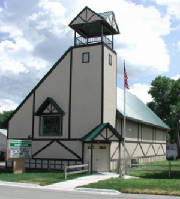
Pierson Wildlife Museum Learning Center- Neligh
A steeple converted to look like an African hunter's lookout tower is the first hint that a wild
animal exhibit has replaced congregants at the former New Abundant Life Church, Neligh, Neb.
Now, the building is The Pierson Wildlife Museum Learning Center, which opened to the public on the Fourth of July. It
includes stuffed elephants, lions, a rhinoceros and a cape buffalo, as well as sheep from Alaska, Canada, the Rocky Mountains
and Mexico.
The collection was donated to this northeast Nebraska city of 1,650 by retired Dr. Kenneth Pierson and his wife,
Margaret, who traveled the world on hunting expeditions.
The city purchased the former church building for $10,000 and leased it to a 15-member group dedicated to preserving
and displaying the collection. Headed by Stan Lichtenberg of Neligh, the committee began renovating the building last November,
and has included a working waterfall and mountain ledges.
Other trophies in the collection include a spotted hyena, ostrich, silver jackal, monkeys, jaguar, markhor, wild
hog, red deer, roebuck, sable antelope, zebra, wart hog, wildebeest, hippopotamus, water buck and kudu.
A stained-glass window in the front of the building, which features a rhinoceros grazing at sunset, was donated by
the Pierson's son, Eric, and his wife, Peg. Eric Pierson is a neurosurgeon in Lincoln, Neb.
A daughter, Karen Rathje of Lincoln, donated the waterfall.
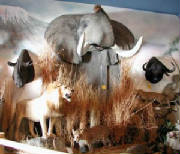

Joslyn Art Museum - Omaha
As Nebraska’s largest and most distinguished art museum, Joslyn Art Museum in Omaha has served
as the premier center for visual art since opening in 1931. Joslyn's collection features work from antiquity to the present,
with an emphasis on 19th- and 20th-century European and American art. Highlights of the permanent collection include works
by Lorenzo di Credi, El Greco, Edgar Degas, Claude Monet, Albert Bierstadt, and Thomas Hart Benton. American masters such
as Grant Wood, Jackson Pollock, Dale Chihuly, and George Segal are also represented.
Joslyn is renowned for its collection of art of the American West, and known worldwide for its collection
of Swiss artist Karl Bodmer’s watercolors and prints documenting his 1832-34 journey to the Missouri River frontier
with German Prince Maximilian of Wied.
The original building is one of the finest examples of Art Deco architecture in the nation,
with 38 marbles from seven countries. In addition to the art galleries, Joslyn features a 1,000 seat concert hall, fountain
court, education technology gallery, lecture hall, library, café, and gift shop.
Several Special Exhibitions are presented each year, complementing the permanent collection and offering
a broad range of art to everyone. Year-round musical performances, educational lectures by national and international scholars, and art classes for all ages further enhance the
Joslyn experience.
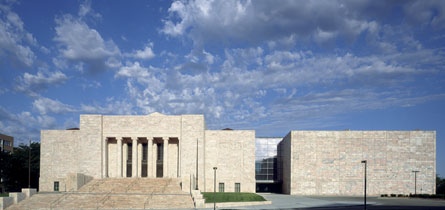
Location: 2200 Dodge Street
Omaha, Nebraska 68102-1292
General Information: 402-342-3300
Fax:
402-342-2376
Hours:
Tuesday - Saturday, 10 am - 4 pm
Sunday, noon - 4 pm
Closed Mondays
and major holidays*
Hours may change for special exhibitions.

Durham Western Heritage Museum - Omaha
Beautiful architecture blends with memories of a time gone by at the historic Durham Western Heritage Museum.
Opened in 1931, Union Station was built by the Union Pacific Railroad as a showpiece in the city of their headquarters. Considered
one of Omaha's most unique treasures, the renovated art deco building offers an exquisite look at Omaha's history.
The Durham Western Heritage Museum offers unique, hands-on learning for people of all ages. Explore Omaha's
history, discover something new in our temporary exhibits and remember the past through our special collections. Explore Omaha
of years past as you learn through today's technology. Throughout the museum, you'll find exhibits that teach you about Omaha's
neighborhoods, notable citizens and interesting historical sites.
Location:
Durham Western Heritage Museum is located in Omaha's Historic Old Market at 801 South 10th Street.
Located on the 10th Street bridge, the Museum can be accessed from both 10th Street and Leavenworth Street.
The Museum has a two level parking deck that is FREE to all visitors.
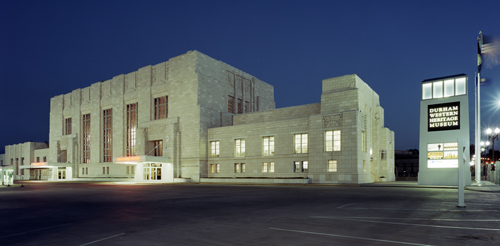
Hours:
|
Monday/Major Holidays |
CLOSED |
|
Tuesday |
10 a.m. - 8 p.m. |
|
Wednesday - Saturday |
10 a.m. - 5 p.m. |
|
Sunday |
1 - 5 p.m. |
 
El Museum Latino- Omaha
El Museo Latino opened its doors in the historic Livestock Exchange Building on May 5,1993 as the first Latino
art & History museum and cultural center in the Midwest. In 1997, the museum moved to its present brick and red tile roof
building. The original construction of 1887 was a school and was reconstructed in the 1930s. Today, El Museo Latino is one
of only eleven Latino museums in the United States.
In conjunction to the exhibits, El Museo Latino develops educational
programs that include lectures, slide presentations, films, art classes, workshops, demonstrations, art history classes, gallery
talks, guided visits, and dance classes. Some of the programs are age specific for K-12, some for post secondary students,
and others are for an adult audience. In addition, El Museo Latino is a resource and a center for Latino studies in the Midwest.
El
Museo Latino organizes and presents special events during the year highlighting the annual Cinco de Mayo celebration in May
and Hispanic Heritage Month in September. May features the annual Almuerzo (brunch) while September features the Hispanic
Heritage celebration Banquet. During the year, Family Day celebrations are also scheduled as well as special dance performances
by the museum's dance company, "CHOMARI" Ballet Folklorico Mexicano, and by visiting artists.
Location: 4701 South 25 Street Omaha, NE 68107
Hours: M-W-F 10AM-5PM T-TH 1PM-5PM SAT 10AM-2PM
 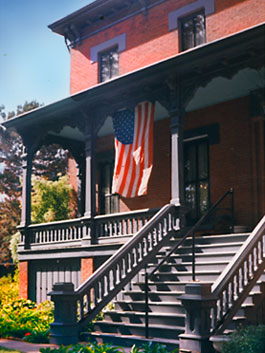
General Crook House Museum - Omaha
The Museum is the authentically restored home of General George Crook. It was constructed in 1879 and is on
the National Register of Historic Places.
General Crook was a Civil War and National Indian Wars hero and was considered the "greatest Indian fighter
in the history of the United States.’’ At the landmark 1879 trial of the Ponca Chief Standing Bear, General Crook
testified in defense of Standing Bear. He was the Commander of the Department of the Platte from 1875 to 1882 and again from
1886 to 1888.
The house is an Italianate style, which represented the no-nonsense grandeur of the military frontier. The
furnishings are from the 1880 Victorian period.
Collections at this living history museum include decorative arts, costumes, art & crafts and period furnishings.
Classes and a reference collection on the history and appreciation of antiques are available.
Victorian Heirloom Garden
Adjoining the Museum is the Crook House Victorian Heirloom Garden, which overlooks the majestic parade ground
and historic buildings of Historic Fort Omaha. Many of the more than 110 varieties of heirloom flowers, trees and shrubs are
native to Nebraska. Some plants were originally carried here on wagon trains or were available by mail order catalog in the
1880s. Perennials surround four central "carpet beds" of annuals, patterned like an Oriental rug to create an outside parlor
where many hours would have been spent to capture the cool breezes.
Hours: Monday-Friday from 10 a.m. to 4 p.m. and Saturday and Sunday from 1 to 4 p.m.
 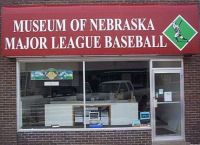
The Museum of Nebraska Major League Baseball - St. Paul
The Museum of Nebraska Major League Baseball is dedicated to illustrating the careers of over 140
men with Nebraska ties who have made it to the Major Leagues of American Baseball. The museum contains artifacts and information
on native Nebraskan's and those with Nebraska roots or ties.
Major displays on the Hall of Fame players illustrate
their baseball careers including trading cards, pictures, and artifacts. Additional displays are being developed for the "Nebraska's
Top 25 Roster" including Les Nunamaker of Malcom, Johnny Hopp of Hastings, Rex Barney of Omaha, Billy Southworth of Harvard,
Adolph Liska of Dwight, Tim Burke of Omaha, and Clarence Mitchell of Aurora.
The Museum is located in the Historic
Downtown District of St. Paul Nebraska at 619 Howard Avenue. This is approximately 5˝ blocks west of U.S. Highway 281. (Turn
west on Howard Avenue at the Pizza Hut). St. Paul is located in central Nebraska 30 minutes north of Interstate 80.
Summer Hours (Memorial Day to Labor Day)
Monday - Friday 10
a.m. to 4 p.m.
Saturday 10 a.m. to 2 p.m.

Arbor Lodge State Historical Park - Nebraska City
This beautiful estate in Nebraska City was home to J. Sterling Morton, founder of Arbor Day. From its beginning
in 1855 as a four-room frame house, the magnificent mansion grew to 52 rooms through several remodelings. Authentic furnishings
grace the rooms, and displays capture the life and times of this exceptional man.
A collection of antique carriages and wagons are displayed in the carriage house, and a stroll through the
beautifully landscaped grounds, formal rose garden and arboretum is a must. Picnicking is permitted on the area. Cider pressing
and other old-time crafts are staged here on last two Sunday afternoons of September and the first two Sundays in October.
Carriage House: Built in 1901 for about $10 000 this structure housed the Morton coaches,
carriages, and carriage horses On display are a Stanhope phaeton, a Vail phaeton, a rockaway, a sidebar runabout, the traditional
surrey, and a Brougham used by President Grover Cleveland The collection also includes an Overland stage, purchased by Carl
Morton.
Italian Terraced Garden: Part of Joy's 1903 addition, the garden was designed by a
noted Boston architect named Manning. Gently curving brick walks guide the visitor along both levels of the cool, shaded rose
garden Highlights include numerous flower and rose beds, as well as a sundial and pergola. Monument Square: Set in the east
part of the park near the entrance is a bronze casting of the author of Arbor Day", J. Sterling Morton It was erected in 1905
and dedicated by President Cleveland. Standing in the foreground is a smaller bronze of the Greek goddess Daphne, who according
to legend was turned into a laurel tree by her father to save her from the pursuit of Apollo.
Log Cabin: Just across the drive from Monument Square is a log house, built on October
2 2, 1890, as a memorial to the old settlers of the community by J. Sterling Morton and other members of the old Seniors Association
It is typical of the early homes used by territorial settlers. Pine Grove: Originally planted by Morton in 1891 to prove to
Governor Furnas that white pines would, indeed, grow in Nebraska, the stand was replanted in 1937 after the great drouth.
The dense carpet of needles and cool shade make it a favorite area with visitors.
Tree Trail: A one-half mile tree trail winds through the original arboretum area planted
by the Mortons The wood-chipped path, cool shaded benches, and labeled trees offer visitors both a pleasant and interesting
experience The arboretum, which encompasses the entire 65 acres of the park, features over 250 varieties of trees and shrubs.
Family Plot: (Wyuka Cemetery)-Historic Wyuka Cemetery, site of the Morton family plot,
is located at 19th Street and 6th CorSo, about 1 1/2 miles southeast of the park entrance The plot is easily recognized by
its 20-foot, hand-hewn rock shaft, shaped like a tree trunk broken at the top.
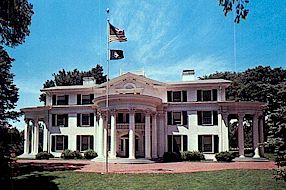
Contact Information:
Arbor Lodge SHP
PO Box 15
Nebraska City, NE 68410-0015
Phone:
(402) 873-7222
 
Strategic Air and Space Museum - Ashland
The Strategic Air & Space Museum is regarded as the nation's foremost facility of its kind,
the $29.5 million museum opened on May 16, 1998, and preserves aircraft and missiles for future generations.
The Museum is a 300,000 square foot building that features a glass atrium, two aircraft display
hangars, a traveling exhibit area, a children's interactive gallery, a 200-seat theater, a Museum store, an aircraft restoration
gallery, and a snack bar.
The glass atrium is a breathtaking structure constructed of 525 glass panels that encase the awesome
Lockheed SR-71 Blackbird. The two aircraft display hangars protect the aircraft collection and exhibits from harsh outdoor
elements. We participate in an exhibit exchange program with other national museums and display them in the traveling exhibit
area.
The children's interactive gallery is both entertaining and educational, and features audiovisual
programs and activities for children of all ages.
Visitors can purchase souvenirs, gifts and educational items from the Museum store, and refresh
themselves at the Plane Food snack bar.
A unique feature of the Museum gives visitors the opportunity to watch the restoration of warplanes
as technicians prepare them for display.
It is located between Omaha and Lincoln off of Interstate 80. Take exit #426 (same exit as
Mahoney St. Park and the Simmons Wildlife Safari Park) and go west 1/2 mile. The museum is located on the right (north) side
of the road.
 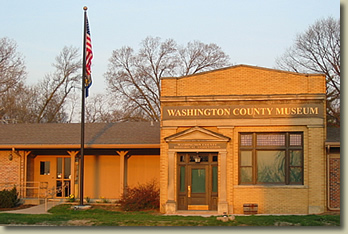
Washington County Historical Museum - Ft Calhoun
The Washington County Historical Museum, the oldest county museum in Nebraska, houses artifacts from
prehistoric time, Native American dress and equipment and relics from nearby Ft. Atkinson. Early farm tools and equipment,
school and household items as well as fine china brought to the county from the old country depict how the pioneers lived
in the 1800s. A display of Thomas Edison items and early telephone equipment moves the visitor into the 20th century. The
library holds early county information valuable to genealogists.
The Washington County Historical Museum is located just north of Omaha, Nebraska on US Highway
75 in Fort Calhoun.
Monday, Wednesday, Thursday & Friday -- 9:00 a.m. to 4:00 p.m.
Saturday & Sunday - 1:00
- 4:00 p.m.
 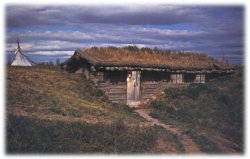
The Museum of the Fur Trade - Chadron
Along the frigid fringes of Civilization, before the era of Thinsulate™ and two-zone heating, native
peoples and pioneers knew how to stay warm. They "borrowed" the hides and fur of cold-weather mammals, and what they didn't
need for themselves, they traded and bartered to others. The Museum of the Fur Trade celebrates and chronicles North
America's first continent-wide economy -- the business of furs, involving trappers, fur traders, and Indians.
The museum is on the site of a trading post and warehouse built along the Bordeauz Creek in 1833, surrounded
by the only hilly, forested region in Nebraska. The post was operated until 1876, when it was shut down after US soldiers
confiscated ammunition being sold to the Indians.
The museum opened adjacent to the site in 1949 -- the only museum for a hundred miles. The old trading post
site was excavated in 1955, the buildings reconstructed a year later. The trading post, a sod and wood hut buried in the ground
-- near a teepee and Indian garden -- is too tiny to house the artifacts in the museum's collection. The museum is in long,
one-story building, and with a $1.7 million plan to expand over the next few years, should be the undisputed fur trade museum
of the world.
The collection includes all the trappings of the fur trade lifestyle -- weapons, clothing, the goods and materials
traded in establishments like this across the continent. There are William Clark fabric samples, Greer Garson's bells, the
earliest "point blanket." Kit Carson's shotgun is a highlight, but nearly lost in a rack of other guns and weapons. The displays
are a sometimes confusing mix for those of us who like our history unconfused -- there are Indian ceremonial garments fashioned
from British buttons and cloth from Europe.
A few unusual exhibits stand out, such as the Buffalo Tongue, a northern plains delicacy back in
pioneer days. Also of note: a parka made from seal intestines.
But there are things to learn here. The first white man to cross the North American continent? Not Lewis or
Clark, but Alexander Mackenzie, a Canadian fur trader.
Today the fur trade continues around the world, albeit at a much smaller scale and without the naked exploitation
of the natives. Every year, about three busloads of Italians visit the museum, and others come from the wolfy regions of Romania
and Bulgaria.
The gift shop is subdued -- no need for furverts to detour here. But visitors can buy pelts: raccoon - $40.,
bobcat $200, wolverine $500. "It’s a world market," the curator said. "The price is set all over the place."
The Museum of the Fur Trade takes itself somewhat seriously -- its scholarly journal, Museum of the Fur
Trade Quarterly, presents articles on the importance of ostrich plumes to fur trade feather merchants, or the market for
a good ice chisel north of the 50th parallel. The Museum of the Fur Trade Story notes: "It may surprise you to learn
that no animal has ever become extinct due to being overhunted for its fur."
From "Roadside America"
6321 Hwy. 20, P.O. Box 1276, Chadron, NE 69337
Daily 8-5, Memorial Day-September; or by appointment.
 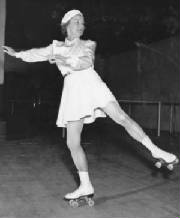
National Museum of Roller Skating - Lincoln
The museum contains the largest collection of historical roller skates, dating to 1819, in the world. It also
contains patents, medals, trophies, photographs, artworks, films and videotapes, costumes, library and archival materials,
and roller skating memorabilia. The museum holds approximately 1,500 volumes of roller skating books and periodicals, including
over 125 titles (American and foreign) in its periodical collection. The archives also includes over 8,000 photographs; personal
papers of individuals prominent in roller skating from 1800 to the present; programs and archival material for local, regional,
national, and international roller skating competitions; and miscellaneous articles and images related to roller skating.
The National Museum of Roller Skating holds the largest, most varied, and unique collection of antique roller
skates in the world. Included in its collection is the James L. Plimpton family collection (considered the father of modern
roller skating), patent models of early skates of American manufacturers, skates of international origin, competitive and
vaudeville costumes, memorabilia of roller skating rinks, in-line roller skates dating from 1819 to present, and various manufacturing
innovations and experiments. The museum archives contain an extensive collection of publications, photographs and documents
covering over two centuries of roller skating history.
Location: 4730 South Street, Lincoln, Nebraska 68506
Hours: The musuem is open from 9:00 a.m. to 5:00 p.m. CST, Monday through Friday. The museum
is closed on weekends and major holidays. Addmission to the museum is free

Telephone Pioneer Museum- Lincoln
The Frank H. Woods Telephone Pioneer Museum was incorporated in 1994 and officially opened in October 1996. It was created
through the hard work of many local Pioneer volunteers, a grant by the Independent Telephone Pioneers Association (ITPA) and
funding and support from Aliant Communications. The museum is named
for Frank S Woods Sr. (1868-1952) who founded Lincoln Telephone Company in 1903. The company began serving 1,800 Lincoln customers
in June 1904. Telephony, an industry publication, praised the new company as "the first large automatically operated
telephone exchange west of Chicago."
Location: 2047 M Street, Lincoln, Nebraska 68508
Phone: 402 436-4640
Hours of Operation Sunday, 1 - 4 p.m. Closed on all major holidays.
Special tours upon request. Admission is free. Goodwill donations are gratefully accepted.
|

